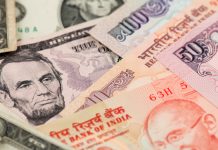- Indian Rupee (INR) falls after gains yesterday
- Indian equities closed higher
- US Dollar (USD) rose after wholesale inflation rose 6% YoY
- US jobless claims also fell
The US Dollar Indian Rupee (USD/INR) exchange rate is rising on Thursday, reversing losses from the previous day. The pair settled -0.19% lower in the previous session, settling at 82.75. At 14:00 UTC, USD/INR trades +0.05% at 82.88 and trades in a range of 82.59 to 82.77.
The rupee is edging lower amid a stronger U.S. dollar. However, it has shown resilience across the session, helped by rising domestic equities and steady oil prices.
Indian equities close the day higher, tracking gains in on Wall Street in the previous session. Over the past four sessions foreign buying of domestic equities has brought in a net ₹45.17 billion, reversing a selling trend earlier in the year.
Meanwhile, oil prices held steady as investors weighed up higher US inventories against an improved demand outlook in China and Russia production cuts.
The US Dollar is rising across the board. The US Dollar Index, which measures the greenback versus a basket of major currencies, trades +0.08% at the time of writing at 104, a monthly high.
The US dollar is rising on Thursday after data showed that wholesale inflation was hotter than expected in January. The producer price index rose 6% year on year in January, well ahead of the 5.4% expected. This was down slightly from 6.2% in December. On a monthly basis, PPI jumped 0.7%, after falling -0.2% in the previous month.
Meanwhile, US jobless claims unexpectedly fell to 194,000, down from 196,000 in the previous week and below the 200,000 initial claims that analysts had penciled in.
The stronger-than-expected data comes after a series of stronger data points across this week, including hotter-than-expected consumer price inflation and surging retail sales. The data points to the Federal Reserve needing to act more aggressively, hiking interest rates for longer in order to tame persistently high inflation.





